Direct-ARPES and STM Investigation of FeSe Thin Film Growth by Nd:YAG Laser
Abstract
1. Introduction
2. Materials and Methods
3. Results
3.1. Structural Properties
3.2. Scanning Tunneling Microscopy
3.3. X-Ray Photoemission Spectroscopy
3.4. Angle Resolved Photoemission Spectroscopy
4. Conclusions
Author Contributions
Funding
Institutional Review Board Statement
Informed Consent Statement
Data Availability Statement
Acknowledgments
Conflicts of Interest
References
- Sakoda, M.; Iida, K.; Naito, M. Recent progress in thin-film growth of Fe-based superconductors: Superior superconductivity achieved by thin films. Supercond. Sci. Technol. 2018, 31, 093001. [Google Scholar] [CrossRef]
- Ding, H.; Lv, Y.F.; Zhao, K.; Wang, W.L.; Wang, L.; Song, C.L.; Chen, X.; Ma, X.C.; Xue, Q.K. High-temperature superconductivity in single-unit-cell FeSe films on anatase TiO2 (001). Phys. Rev. Lett. 2016, 117, 1–5. [Google Scholar] [CrossRef]
- Wang, Q.; Zhang, W.; Zhang, Z.; Sun, Y.; Xing, Y.; Wang, Y.; Wang, L.; Ma, X.; Xue, Q.K.; Wang, J. Thickness dependence of superconductivity and superconductor- insulator transition in ultrathin FeSe films on SrTiO3 (001) substrate. 2D Mater. 2015, 2. [Google Scholar] [CrossRef]
- Mele, P. Superconducting properties of iron chalcogenide thin films. Sci. Technol. Adv. Mater. 2012, 13, 054301. [Google Scholar] [CrossRef]
- McQueen, T.M.; Williams, A.J.; Stephens, P.W.; Tao, J.; Zhu, Y.; Ksenofontov, V.; Casper, F.; Felser, C.; Cava, R.J. Tetragonal-to-orthorhombic structural phase transition at 90 K in the superconductor Fe1.01Se. Phys. Rev. Lett. 2009, 103, 057002. [Google Scholar] [CrossRef]
- Watson, M.D.; Kim, T.K.; Haghighirad, A.A.; Davies, N.R.; McCollam, A.; Narayanan, A.; Blake, S.F.; Chen, Y.L.; Ghannadzadeh, S.; Schofield, A.J.; et al. Emergence of the nematic electronic state in FeSe. Phys. Rev. B 2015, 91, 155106. [Google Scholar] [CrossRef]
- Shimojima, T.; Suzuki, Y.; Nakamura, A.; Mitsuishi, N.; Kasahara, S.; Shibauchi, T.; Matsuda, Y.; Ishida, Y.; Shin, S.; Ishizaka, K. Ultrafast nematic-orbital excitation in FeSe. Nat. Commun. 2019, 10, 1–6. [Google Scholar] [CrossRef]
- Liu, X.; Zhao, L.; He, S.; He, J.; Liu, D.; Mou, D.; Shen, B.; Hu, Y.; Huang, J.; Zhou, X.J. Electronic structure and superconductivity of FeSe-related superconductors. J. Phys. Condens. Matter 2015, 27, 183201. [Google Scholar] [CrossRef]
- Nie, Y.F.; Brahimi, E.; Budnick, J.I.; Hines, W.A.; Jain, M.; Wells, B.O. Suppression of superconductivity in FeSe films under tensile strain. Appl. Phys. Lett. 2009, 94, 95–98. [Google Scholar] [CrossRef]
- Liu, D.; Zhang, W.; Mou, D.; He, J.; Ou, Y.B.; Wang, Q.Y.; Li, Z.; Wang, L.; Zhao, L.; He, S.; et al. Electronic origin of high-temperature superconductivity in single-layer FeSe superconductor. Nat. Commun. 2012, 3, 1–6. [Google Scholar] [CrossRef] [PubMed]
- Tan, S.; Zhang, Y.; Xia, M.; Ye, Z.; Chen, F.; Xie, X.; Peng, R.; Xu, D.; Fan, Q.; Xu, H.; et al. Interface-induced superconductivity and strain-dependent spin density waves in FeSe/SrTiO3 thin films. Nat. Mater. 2013, 12, 634–640. [Google Scholar] [CrossRef] [PubMed]
- He, S.; He, J.; Zhang, W.; Zhao, L.; Liu, D.; Liu, X.; Mou, D.; Ou, Y.B.; Wang, Q.Y.; Li, Z.; et al. Phase diagram and electronic indication of high-temperature superconductivity at 65 K in single-layer FeSe films. Nat. Mater. 2013, 12, 605–610. [Google Scholar] [CrossRef] [PubMed]
- Zhang, W.H.; Sun, Y.; Zhang, J.S.; Li, F.S.; Guo, M.H.; Zhao, Y.F.; Zhang, H.M.; Peng, J.P.; Xing, Y.; Wang, H.C.; et al. Direct observation of high-temperature superconductivity in one-unit-cell FeSe films. Chin. Phys. Lett. 2014, 31. [Google Scholar] [CrossRef]
- Lee, J.J.; Schmitt, F.T.; Moore, R.G.; Johnston, S.; Cui, Y.T.; Li, W.; Yi, M.; Liu, Z.K.; Hashimoto, M.; Zhang, Y.; et al. Interfacial mode coupling as the origin of the enhancement of Tc in FeSe films on SrTiO3. Nature 2014, 515, 245–248. [Google Scholar] [CrossRef] [PubMed]
- Liu, X.; Liu, D.; Zhang, W.; He, J.; Zhao, L.; He, S.; Mou, D.; Li, F.; Tang, C.; Li, Z.; et al. Dichotomy of the electronic structure and superconductivity between single-layer and double-layer FeSe/SrTiO3 films. Nat. Commun. 2014, 5, 5047. [Google Scholar] [CrossRef]
- Suzuki, Y.; Shimojima, T.; Sonobe, T.; Nakamura, A.; Sakano, M.; Tsuji, H.; Omachi, J.; Yoshioka, K.; Kuwata-Gonokami, M.; Watashige, T.; et al. Momentum-dependent sign inversion of orbital order in superconducting FeSe. Phys. Rev. B 2015, 92, 205117. [Google Scholar] [CrossRef]
- Ge, J.F.; Liu, Z.L.; Liu, C.; Gao, C.L.; Qian, D.; Xue, Q.K.; Liu, Y.; Jia, J.F. Superconductivity above 100 K in single-layer FeSe films on doped SrTiO3. Nat. Mater. 2015, 14, 285–289. [Google Scholar] [CrossRef] [PubMed]
- Biswas, P.K.; Salman, Z.; Song, Q.; Peng, R.; Zhang, J.; Shu, L.; Feng, D.L.; Prokscha, T.; Morenzoni, E. Direct evidence of superconductivity and determination of the superfluid density in buried ultrathin FeSe grown on SrTiO3. Phys. Rev. B 2018, 97, 174509. [Google Scholar] [CrossRef]
- Shigekawa, K.; Nakayama, K.; Kuno, M.; Phan, G.N.; Owada, K.; Sugawara, K.; Takahashi, T.; Sato, T. Dichotomy of superconductivity between monolayer FeS and FeSe. Proc. Natl. Acad. Sci. USA 2019, 116, 24470–24474. [Google Scholar] [CrossRef]
- Wang, Z.; Liu, C.; Liu, Y.; Wang, J. High-temperature superconductivity in one-unit-cell FeSe films. J. Phys. Condens. Matter 2017, 29. [Google Scholar] [CrossRef]
- Orgiani, P.; Bigi, C.; Kumar Das, P.; Fujii, J.; Ciancio, R.; Gobaut, B.; Galdi, A.; Sacco, C.; Maritato, L.; Torelli, P.; et al. Structural and electronic properties of Bi2Se3 topological insulator thin films grown by pulsed laser deposition. Appl. Phys. Lett. 2017, 110, 1–6. [Google Scholar] [CrossRef]
- Bigi, C.; Orgiani, P.; Nardi, A.; Troglia, A.; Fujii, J.; Panaccione, G.; Vobornik, I.; Rossi, G. Robustness of topological states in Bi2 Se3 thin film grown by Pulsed Laser Deposition on (001)-oriented SrTiO3 perovskite. Appl. Surf. Sci. 2019, 473, 190–193. [Google Scholar] [CrossRef]
- Burdastyh, M.V.; Postolova, S.V.; Proslier, T.; Ustavshikov, S.S.; Antonov, A.V.; Vinokur, V.M.; Mironov, A.Y. Superconducting phase transitions in disordered NbTiN films. Sci. Rep. 2020, 10, 1471. [Google Scholar] [CrossRef] [PubMed]
- Yoo, C.; Kim, W.; Jeon, J.W.; Park, E.S.; Ha, M.; Lee, Y.K.; Hwang, C.S. Atomic layer deposition of Gex Se1–x thin films for endurable ovonic threshold selectors with a low threshold voltage. ACS Appl. Mater. Interfaces 2020, 12, 23110–23118. [Google Scholar] [CrossRef]
- Kurth, F.; Reich, E.; Hänisch, J.; Ichinose, A.; Tsukada, I.; Hühne, R.; Trommler, S.; Engelmann, J.; Schultz, L.; Holzapfel, B.; et al. Versatile fluoride substrates for Fe-based superconducting thin films. Appl. Phys. Lett. 2013, 102. [Google Scholar] [CrossRef]
- Qiu, W.; Ma, Z.; Patel, D.; Sang, L.; Cai, C.; Shahriar Al Hossain, M.; Cheng, Z.; Wang, X.; Dou, S.X. The interface structure of FeSe thin film on CaF2 substrate and its influence on the superconducting performance. ACS Appl. Mater. Interfaces 2017, 9, 37446–37453. [Google Scholar] [CrossRef] [PubMed]
- Nanoscience Foundries and Fine Analysis. Available online: www.trieste.nffa.eu (accessed on 5 December 2020).
- Chaluvadi, S.K.; Mondal, D.; Bigi, C.; Knez, D.; Rajak, P.; Ciancio, R.; Fujii, J.; Panaccione, G.; Vobornik, I.; Rossi, G.; et al. Pulsed laser deposition of thin films by means of Nd:YAG laser source operating at its 1st harmonic: Recent approaches and advances. J. Phys. Mater. 2021. [Google Scholar] [CrossRef]
- Panaccione, G.; Vobornik, I.; Fujii, J.; Krizmancic, D.; Annese, E.; Giovanelli, L.; Maccherozzi, F.; Salvador, F.; De Luisa, A.; Benedetti, D.; et al. Advanced photoelectric effect experiment beamline at Elettra: A surface science laboratory coupled with Synchrotron Radiation. Rev. Sci. Instrum. 2009, 80, 043105. [Google Scholar] [CrossRef]
- Bigi, C.; Das, P.K.; Benedetti, D.; Salvador, F.; Krizmancic, D.; Sergo, R.; Martin, A.; Panaccione, G.; Rossi, G.; Fujii, J.; et al. Very efficient spin polarization analysis (VESPA): New exchange scattering-based setup for spin-resolved ARPES at APE-NFFA beamline at Elettra. J. Synchrotron Radiat. 2017, 24, 750–756. [Google Scholar] [CrossRef]
- Feng, Z.; Yuan, J.; He, G.; Hu, W.; Lin, Z.; Li, D.; Jiang, X.; Huang, Y.; Ni, S.; Li, J.; et al. Tunable critical temperature for superconductivity in FeSe thin films by pulsed laser deposition. Sci. Rep. 2018, 8, 1–6. [Google Scholar] [CrossRef]
- Windt, D.L. IMD—Software for modeling the optical properties of multilayer films. Comput. Phys. 1998, 12, 360. [Google Scholar] [CrossRef]
- Orgiani, P.; Perucchi, A.; Knez, D.; Ciancio, R.; Bigi, C.; Chaluvadi, S.K.; Fujii, J.; Vobornik, I.; Panaccione, G.; Rossi, G.; et al. Tuning the optical absorption of anatase thin films across the visible-to-near-infrared spectral region. Phys. Rev. Appl. 2020, 13, 044011. [Google Scholar] [CrossRef]
- Nardi, A.; Bigi, C.; Kumar Chaluvadi, S.; Ciancio, R.; Fujii, J.; Vobornik, I.; Panaccione, G.; Rossi, G.; Orgiani, P. Analysis of metal-insulator crossover in strained SrRuO3 thin films by X-ray photoelectron spectroscopy. Coatings 2020, 10, 780. [Google Scholar] [CrossRef]
- Mostako, A.T.T.; Khare, A. Effect of target–substrate distance onto the nanostructured rhodium thin films via PLD technique. Appl. Nanosci. 2012, 2, 189–193. [Google Scholar] [CrossRef]
- Zhuang, J.C.; Yeoh, W.K.; Cui, X.Y.; Kim, J.H.; Shi, D.Q.; Shi, Z.X.; Ringer, S.P.; Wang, X.L.; Dou, S.X. Enhancement of transition temperature in FexSe0.5Te0.5 film via iron vacancies. Appl. Phys. Lett. 2014, 104, 262601. [Google Scholar] [CrossRef]
- Song, C.L.; Wang, Y.L.; Cheng, P.; Jiang, Y.P.; Li, W.; Zhang, T.; Li, Z.; He, K.; Wang, L.; Jia, J.F.; et al. Direct observation of nodes and twofold symmetry in FeSe superconductor. Science 2011, 332, 1410–1413. [Google Scholar] [CrossRef]
- Cho, J.S.; Park, J.S.; Kang, Y.C. Preparation of Hollow Fe2SO3 Nanorods and Nanospheres by Nanoscale Kirkendall Diffusion, and Their Electrochemical Properties for Use in Lithium-Ion Batteries. Sci. Rep. 2016, 6, 1–13. [Google Scholar] [CrossRef] [PubMed]
- Telesca, D.; Nie, Y.; Budnick, J.I.; Wells, B.O.; Sinkovic, B. Impact of valence states on the superconductivity of iron telluride and iron selenide films with incorporated oxygen. Phys. Rev. B 2012, 85, 214517. [Google Scholar] [CrossRef]
- Telesca, D.; Nie, Y.; Budnick, J.I.; Wells, B.O.; Sinkovic, B. Surface valence states and stoichiometry of non-superconducting and superconducting FeTe films. Surf. Sci. 2012, 606, 1056–1061. [Google Scholar] [CrossRef]
- Zhang, Y.; He, C.; Ye, Z.R.; Jiang, J.; Chen, F.; Xu, M.; Ge, Q.Q.; Xie, B.P.; Wei, J.; Aeschlimann, M.; et al. Symmetry breaking via orbital-dependent reconstruction of electronic structure in detwinned NaFeAs. Phys. Rev. B 2012, 85, 085121. [Google Scholar] [CrossRef]
- Damascelli, A. Probing the electronic structure of complex systems by ARPES. Phys. Scr. 2004, T109, 61. [Google Scholar] [CrossRef]
- Vobornik, I.; Fujii, J.; Mulazzi, M.; Panaccione, G.; Hochstrasser, M.; Rossi, G. Surface electron bands and Fermi surface of Be(0001). Phys. Rev. B—Condens. Matter Mater. Phys. 2005, 72, 3–8. [Google Scholar] [CrossRef]
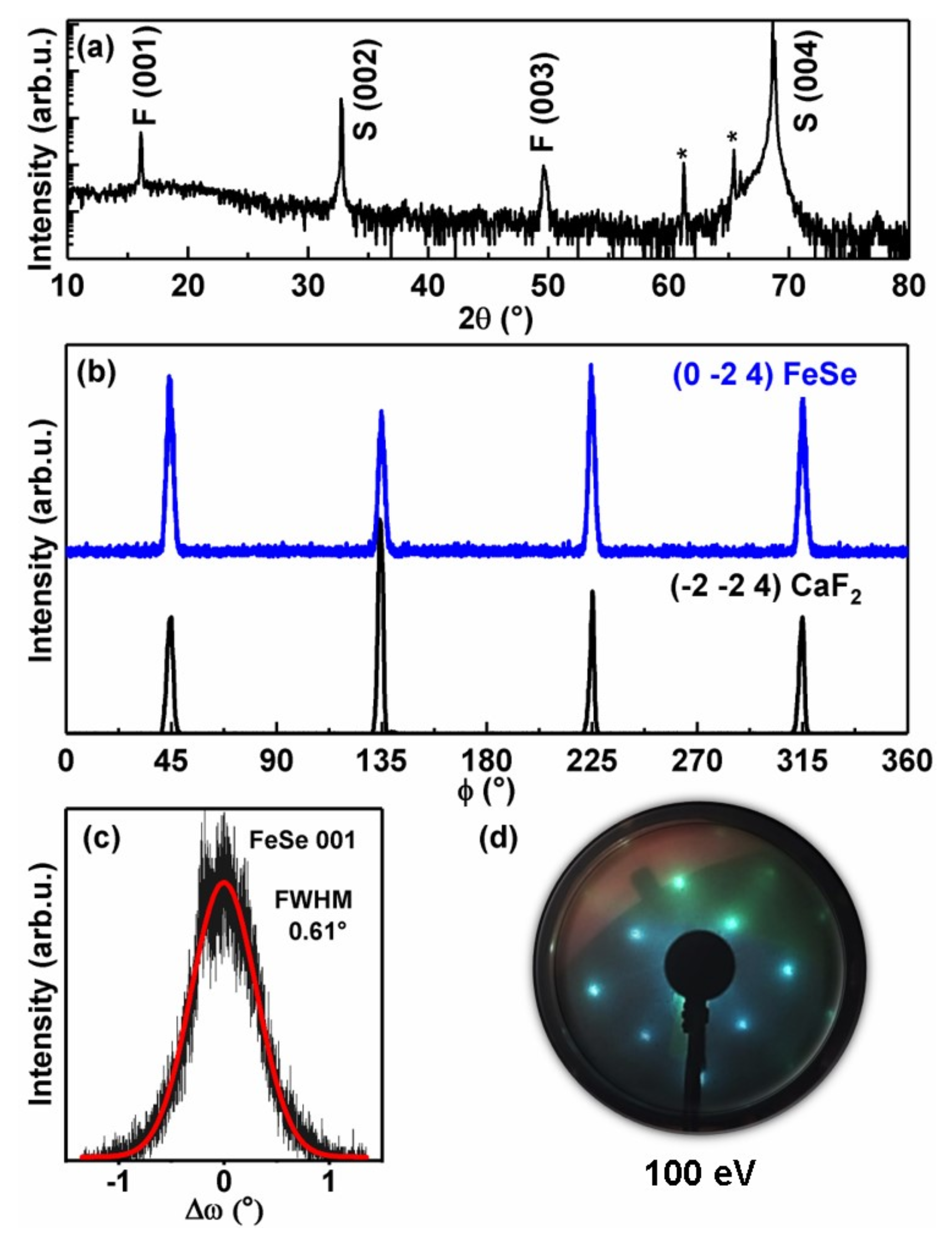
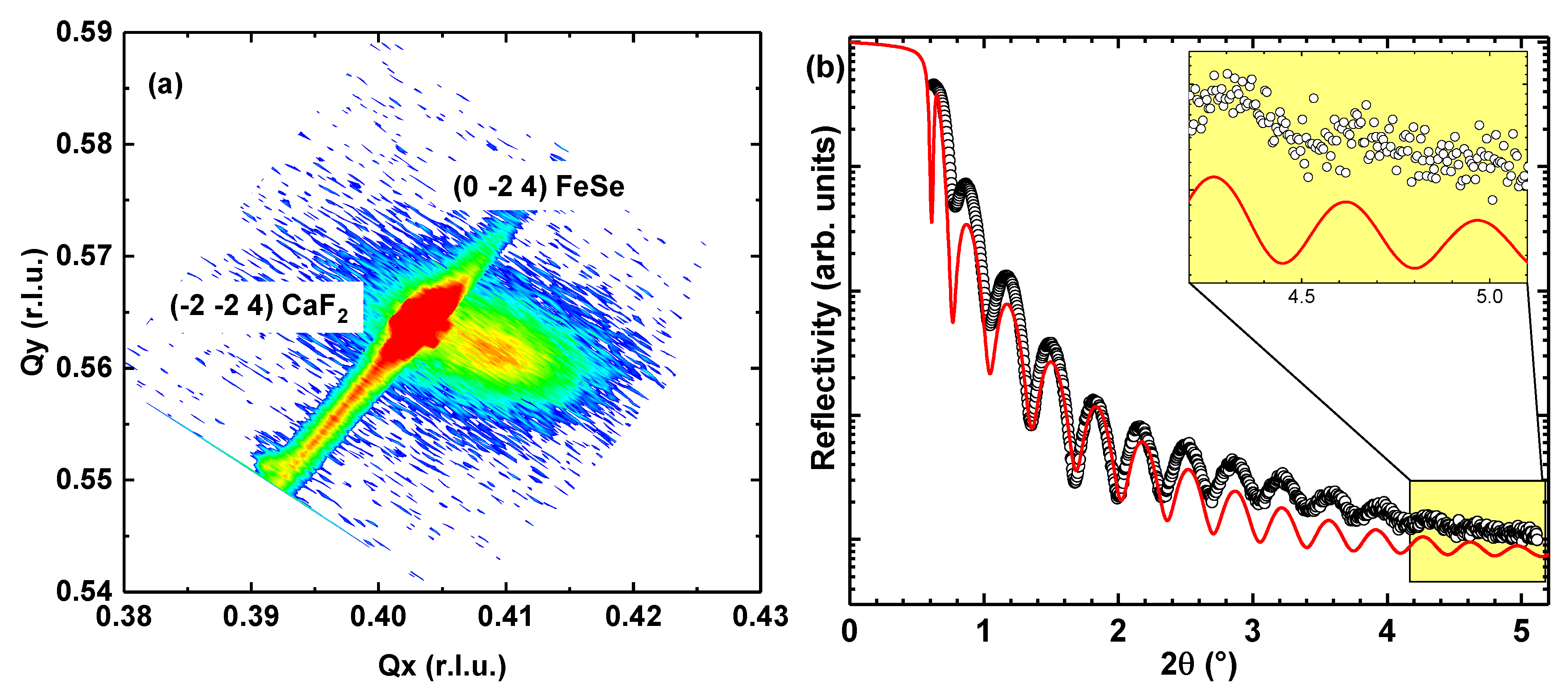
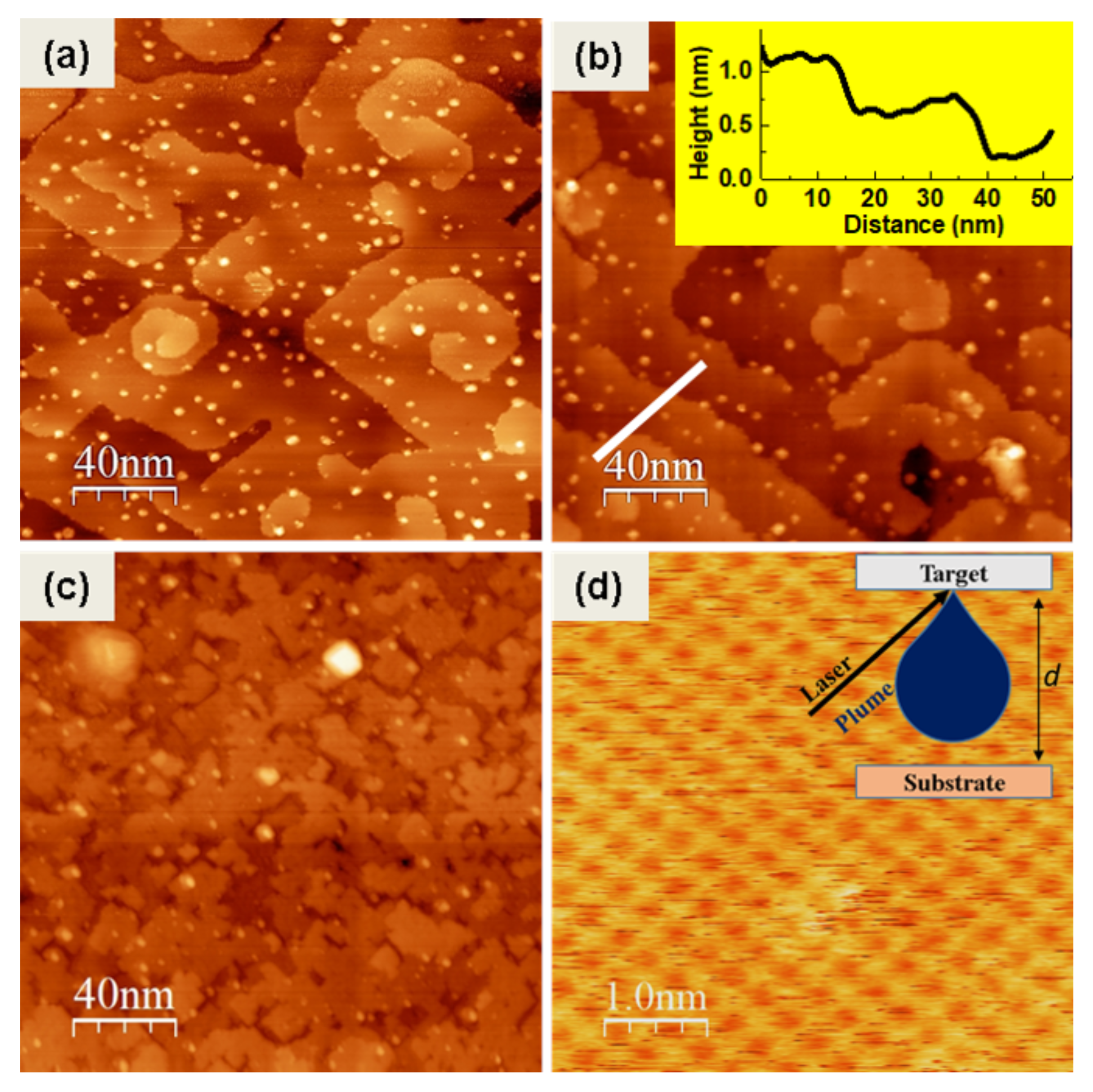
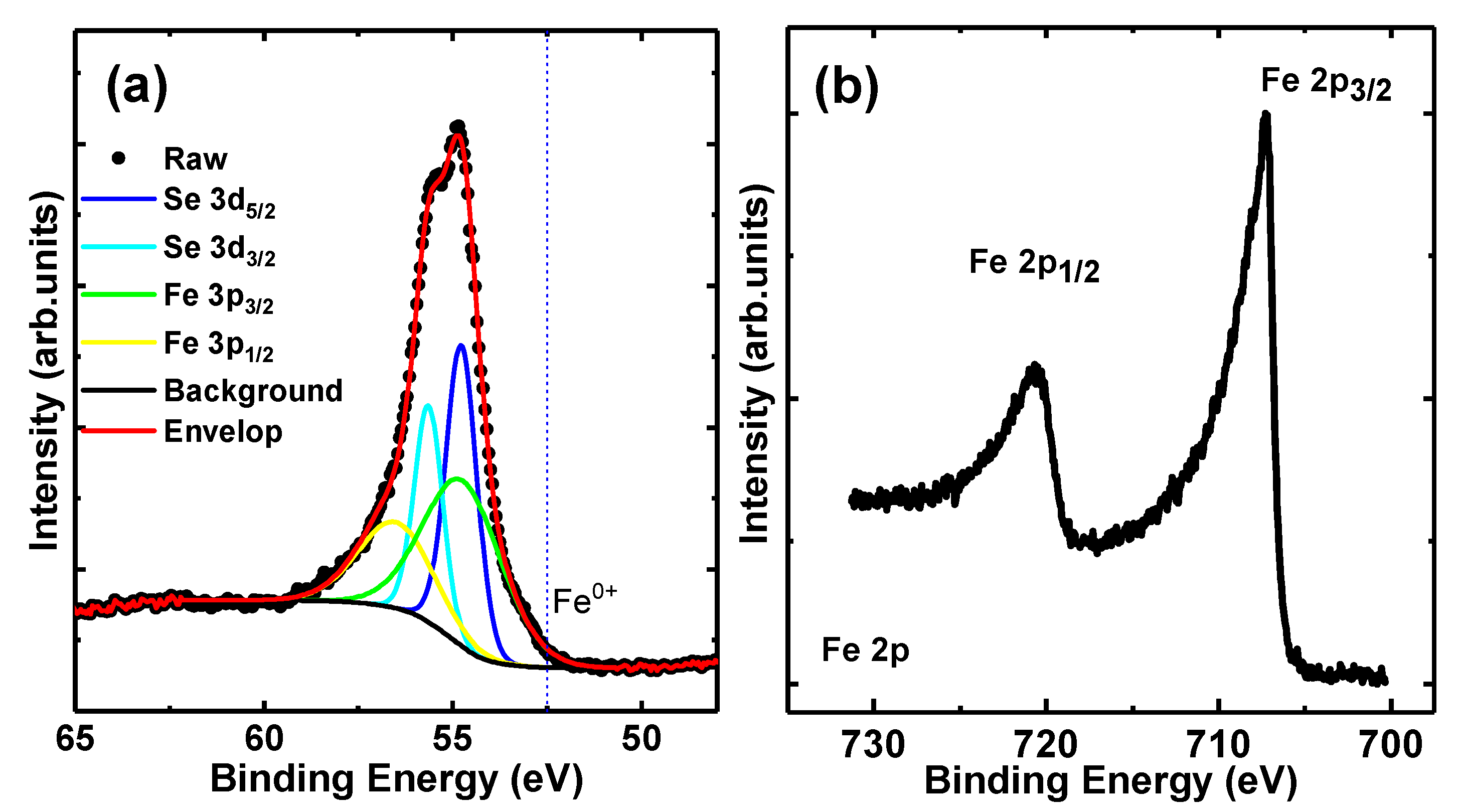

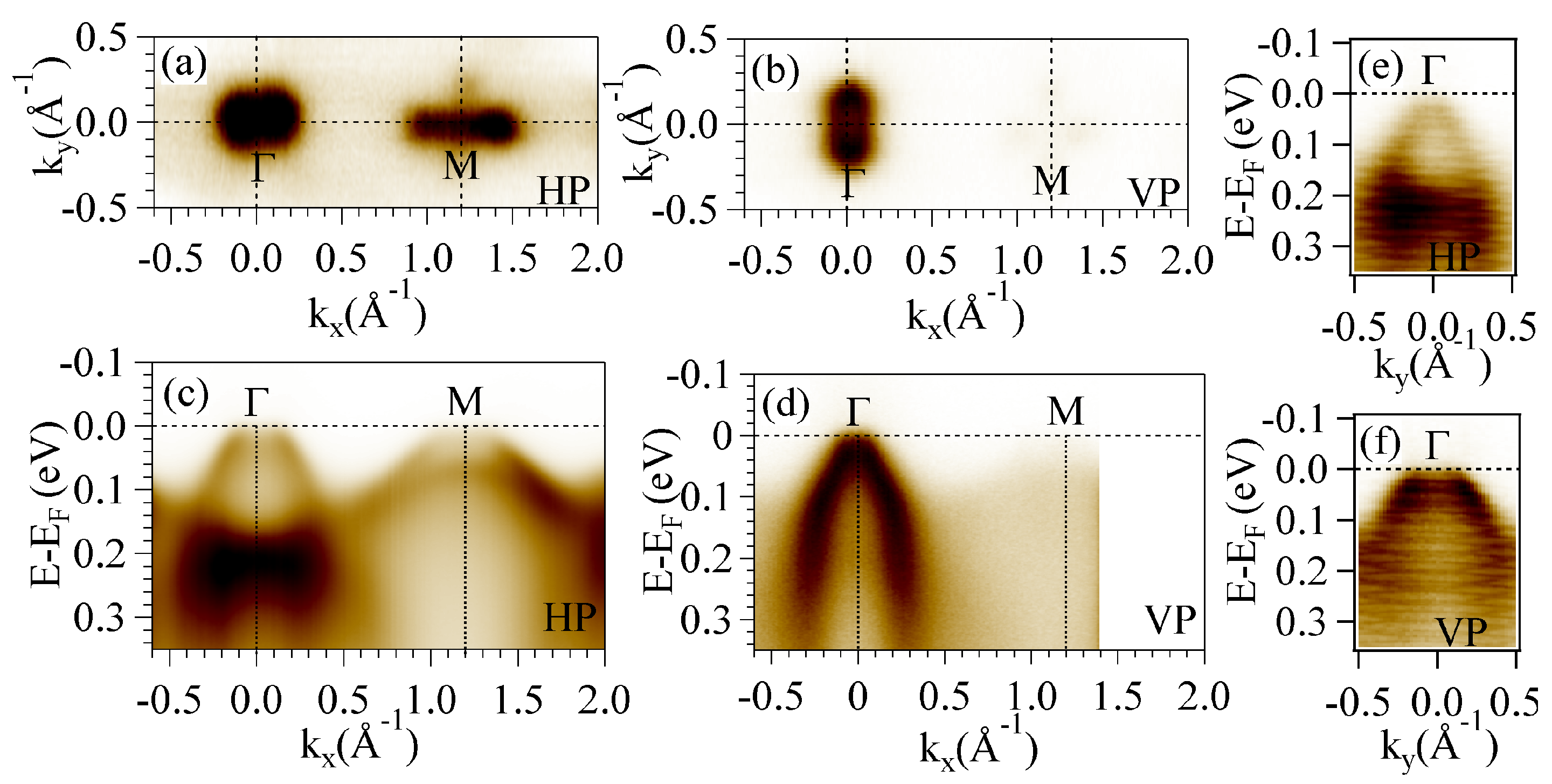
Publisher’s Note: MDPI stays neutral with regard to jurisdictional claims in published maps and institutional affiliations. |
© 2021 by the authors. Licensee MDPI, Basel, Switzerland. This article is an open access article distributed under the terms and conditions of the Creative Commons Attribution (CC BY) license (http://creativecommons.org/licenses/by/4.0/).
Share and Cite
Chaluvadi, S.K.; Mondal, D.; Bigi, C.; Fujii, J.; Adhikari, R.; Ciancio, R.; Bonanni, A.; Panaccione, G.; Rossi, G.; Vobornik, I.; et al. Direct-ARPES and STM Investigation of FeSe Thin Film Growth by Nd:YAG Laser. Coatings 2021, 11, 276. https://doi.org/10.3390/coatings11030276
Chaluvadi SK, Mondal D, Bigi C, Fujii J, Adhikari R, Ciancio R, Bonanni A, Panaccione G, Rossi G, Vobornik I, et al. Direct-ARPES and STM Investigation of FeSe Thin Film Growth by Nd:YAG Laser. Coatings. 2021; 11(3):276. https://doi.org/10.3390/coatings11030276
Chicago/Turabian StyleChaluvadi, Sandeep Kumar, Debashis Mondal, Chiara Bigi, Jun Fujii, Rajdeep Adhikari, Regina Ciancio, Alberta Bonanni, Giancarlo Panaccione, Giorgio Rossi, Ivana Vobornik, and et al. 2021. "Direct-ARPES and STM Investigation of FeSe Thin Film Growth by Nd:YAG Laser" Coatings 11, no. 3: 276. https://doi.org/10.3390/coatings11030276
APA StyleChaluvadi, S. K., Mondal, D., Bigi, C., Fujii, J., Adhikari, R., Ciancio, R., Bonanni, A., Panaccione, G., Rossi, G., Vobornik, I., & Orgiani, P. (2021). Direct-ARPES and STM Investigation of FeSe Thin Film Growth by Nd:YAG Laser. Coatings, 11(3), 276. https://doi.org/10.3390/coatings11030276







